October 6, 2023
Air Date: October 6, 2023
FULL SHOW
SEGMENTS
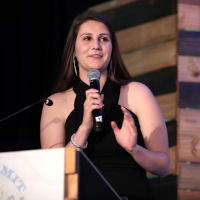
Young Conservatives Tired of Climate Denial
View the page for this story
As the 2024 campaign season heats up, some young Republicans want their party to move on from climate denial and offer solutions. Karly Matthews is Vice President of the American Conservation Coalition and joins Host Jenni Doering to discuss policies that align with the environmental roots of the party. (10:13)

Salt Water in the Mississippi
View the page for this story
Amid widespread drought, salty water from the Gulf of Mexico is slowly seeping up the Mississippi River towards New Orleans, Louisiana. Halle Parker of public radio station WWNO explains the situation, how it's linked to climate change and possible solutions to Host Jenni Doering. (08:42)
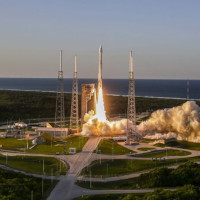
Rocks from Another (Little) World
View the page for this story
The spacecraft OSIRIS-REx has successfully delivered a sample from the asteroid Bennu to Earth. Scientists like Dr. Vicky Hamilton, a planetary geologist and co-investigator on the OSIRIS-REx mission, are eager to study the rocky material and see if it can unveil anything about the origins of our solar system. Dr. Hamilton joins Host Aynsley O’Neill to share surprising findings from the mission. (09:33)
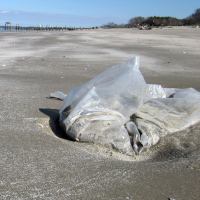
Beyond the Headlines
/ Peter DykstraView the page for this story
This week, Living on Earth Contributor Peter Dykstra and Host Aynsley O’Neill talk about the plan to phase out single use plastics on U.S. public lands, and the late Senator Dianne Feinstein of California’s environmental record. In history, the Erie Canal has a big birthday – 200 years – since its dedication. (04:38)
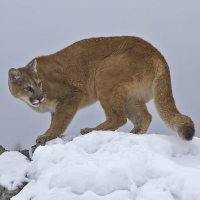
Living with Cougars on the Olympic Peninsula
/ Liza GrossView the page for this story
When a cougar on the Olympic Peninsula in Washington State makes a meal out of someone’s goat or chicken, it can end up with a bounty on its head. But there are non-lethal methods to deter cougars from taking livestock and pets. Liza Gross of Inside Climate News joins Host Aynsley O’Neill to discuss. (13:39)
Show Credits and Funders
Show Transcript
231006 Transcript
HOSTS: Jenni Doering, Aynsley O’Neill
GUESTS: Vicky Hamilton, Liza Gross, Karly Matthews, Halle Parker
REPORTERS: Peter Dykstra
[THEME]
O’NEILL: From PRX – this is Living On Earth.
[THEME]
O’NEILL: I’m Aynsley O’Neill
DOERING: And I’m Jenni Doering.
Some young conservatives want the GOP to move on from climate denial.
MATTHEWS: Climate change and hoax should not be used in the same sentence. I think frankly the American people want to hear how presidential candidates are going to make their communities healthier, are going to make their lives better. They don't want to hear politicians debating climate science, right? They want solutions.
DOERING: And NASA completes its first mission to bring back a pristine sample from an asteroid.
HAMILTON: You're watching that capsule, you know, enter the Earth's atmosphere, you're just biting your nails until you see that parachute deploy. And then when we saw the first pictures of how the capsule had landed in Utah, it was gorgeous.
DOERING: Those stories and more, this week on Living on Earth – Stick Around!
[NEWSBREAK MUSIC: Boards Of Canada “Zoetrope” from “In A Beautiful Place Out In The Country” (Warp Records 2000)]
[THEME]
Young Conservatives Tired of Climate Denial

Karly Matthews is Vice President of Communications for the American Conservation Coalition, an organization whose mission is to build the conservative environmental movement. (Photo: American Conservation Coalition)
O’NEILL: From PRX and the Jennifer and Ted Stanley Studios at the University of Massachusetts, Boston this is Living on Earth. I’m Aynsley O’Neill.
DOERING: And I’m Jenni Doering.
The Republican party has seen its fair share of environmental leaders throughout American history. President “Teddy” Roosevelt created the U.S. Forest Service and doubled the number of sites in the national park system and President Nixon signed both the Clean Air Act and the Endangered Species Act. But things took a turn when the powerful fossil fuel lobby put an enormous amount of pressure on politicians, especially on the right. So many Republican politicians started to downplay or outright deny the science of climate change, like former President Donald Trump who dismissed it as a “hoax.” But as the 2024 campaign season heats up, some young Republicans want their party to move on from this denial. Karly Matthews, Vice President of the American Conservation Coalition, says it’s about getting back to the environmental roots of the party.
MATTHEWS: A lot of people in 2023 polarized politics don't think that conservative and conservation are really compatible. But when you look back in US history, Republican presidents were really instrumental in a lot of environmental protection, legislation and initiatives. At the end of the day, we want to conserve what is good about our country. And at ACC, we see our natural environment as being a huge part of that. We see environmental stewardship as being very compatible with the idea of conserving the land, of leaving the earth better for future generations. And we see a lot of kind of traditionally conservative demographics like farmers, ranchers, outdoorsman, hunters, fishers, all of those people have this kind of conservation ethos, and have been kind of alienated by an environmental movement that might focus more on preservation or regulations or top down solutions. And we see a really big opportunity to show those demographics that you can be an environmentalist and be a hunter or be a farmer. So what we really see our role is to build and kind of reignite that conservation ethos within the conservative movement.
DOERING: And what about traditional energy workers?
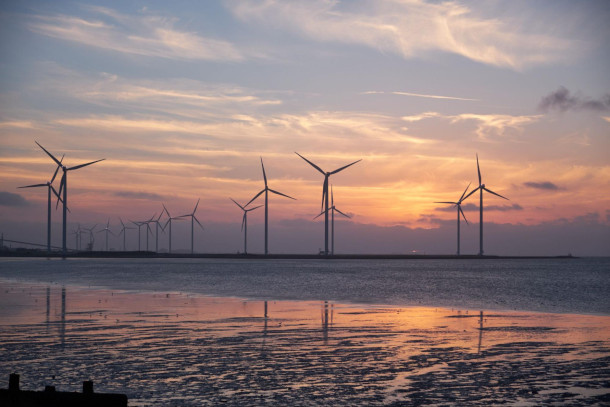
It often takes years to get clean energy projects on the grid. ACC says permitting reform could speed up that process. (Photo: Pixabay, Pexels)
MATTHEWS: Absolutely, I think this is a great question. And it's something we really have to reckon with if we want to have a clean energy transition. And to be clear, ACC supports clean energy, we want to see more clean energy on the grid. But at the same time, messaging like, we're going to shut down all coal plants tomorrow, is not only not feasible for our energy demands, but also, that's leaving a lot of folks behind. And it's not a sustainable way to transition to a clean future. So we see, you know, workforce development as a really important part of the clean energy transition. I think 70 some percent of skills that someone uses in a coal plant can be transferred to a nuclear power plant. That's really encouraging, right? So I think it's just really important when you're messaging with traditional energy workers that a clean energy transition is not necessarily taking something away from them, and it can really be an opportunity.
DOERING: Now, the Intergovernmental Panel on Climate Change, or IPCC, is calling for a rapid reduction in carbon emissions, 50% by the end of this decade, in order to avert climate disaster. So what kinds of climate policies can move quickly while also aligning with conservative values?
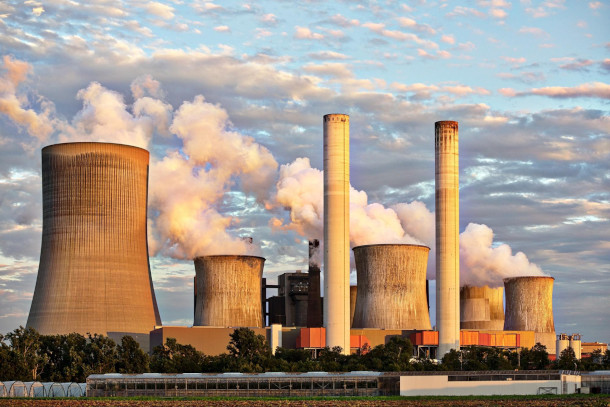
Many conservative environmentalists say the government should incentivize clean nuclear energy. (Photo: Pixabay, Pexels)
MATTHEWS: Yeah, the first thing that comes to mind here is permitting reform. And this idea that, you know, the United States is requiring energy companies to spend millions of dollars and years of time to get energy projects online is frankly absurd. We built the Empire State Building in a year. And it takes, you know, decades to get an offshore wind farm online. We can still have very high environmental standards, but speed up these processes. So making sure that our federal offices are staffed properly, and can actually respond to all these requests, making sure that there's kind of a rapid avenue for advocacy groups or citizens to be heard in these processes. So when we're talking about needing to rapidly reduced emissions, cutting that red tape is so so important. The other way here is incentives. And we see this a lot with you know, tax credits, or voluntary conservation programs. I think we definitely need to be incentivizing things like nuclear energy. But we really see that kind of idea of like a carrot rather than a stick. And there's really evidence for this, right, because the Waxman-Markey Bill was really kind of the talk of climate action during the Obama years. It never became law. But actually, we exceeded emissions reductions that were estimated in that bill without even passing it because the private sector took incentives from the federal government, to be sure, but really stepped up and decided, you know, we need to reduce emissions. But we really see the government stepping in and frankly, making it easier for companies, nonprofits, regular citizens, to take action on these issues, rather than kind of putting barriers up in their way. So I think when we're talking about speed, it's also natural climate solutions, you know, ecosystem restoration, regenerative agriculture, active forest management, those are things we can be doing right now.
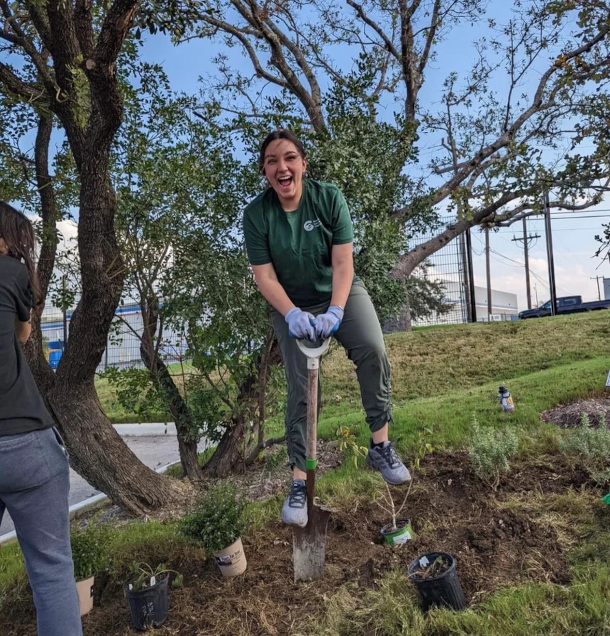
The ACC supports local, grassroots ecological restoration. (Photo: American Conservation Coalition)
DOERING: And by forest management, you mean like going in and doing regular thinning of trees, so doing some logging selectively to keep down that excess fuel?
MATTHEWS: Absolutely, yeah. And especially when it comes to forest management, there's a lot of pushback from a lot of traditional environmental groups on this. But if we continue to kind of take this preservation approach to managing our forests, we're going to continue to have these out of control wildfires, that of course, sometimes are human ignited or exacerbated by climate change. But at the end of the day, if a forest is poorly managed, it's going to ignite faster and it's going to spread rapidly. So really making sure that we're doing everything that we can to reduce unnecessary emissions like that.
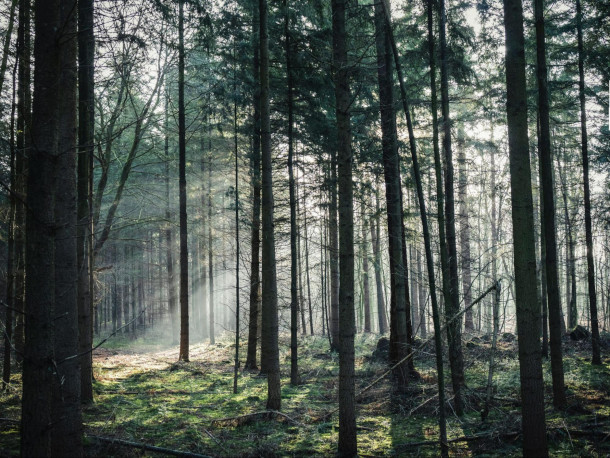
Advocates of forest management say the practice may prevent wildfires by removing excess fuel. (Photo: Lukas Hartmann, Pexels)
DOERING: So Karly, in the first presidential debate, one of the Republican presidential candidates, Vivek Ramaswamy, called the climate change agenda a "hoax," which was met with boos from the audience. And that's something former President Trump has repeated over and over again as well. How well or poorly do you think denying the science of climate change is actually playing with conservative voters these days?
MATTHEWS: Well, I can say with the utmost confidence, it does not play with the conservative audience. ACC was very firm in saying that, you know, climate change and hoax should not be used in the same sentence. I think, frankly, the American people want to hear how presidential candidates are going to make their communities healthier, are going to make their lives better. They don't want to hear politicians debating climate science, right? They want solutions.
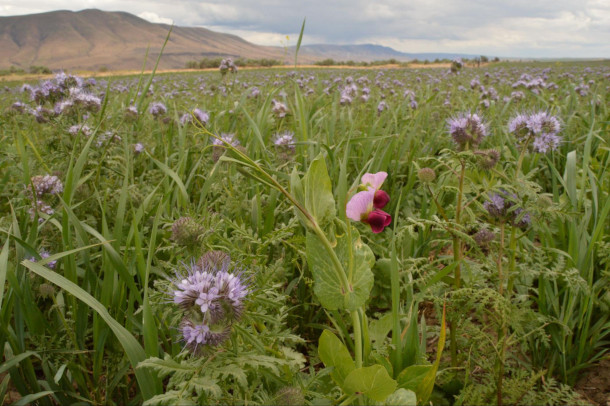
Regenerative agriculture practices like planting cover crops can restore soil health and sequester carbon and are attracting bipartisan support. (Photo: Garrett Duyck, NRCS Oregon, Flickr, CC BY-ND 2.0)
DOERING: In late 2022, Pew Research Center found that 73% of Republicans ages 18 to 39 think that climate change is a serious problem. From your experience, what are especially young Republicans expecting from these presidential candidates running in 2024?
MATTHEWS: I think what young conservatives want from a presidential candidate is, frankly, to acknowledge that climate change is happening and pivot to solutions that are going to bolster the economy, but also protect our environment. And I think that a lot of times, that second part is actually there in a lot of messaging, but it's not clearly tied back to, yes, climate change is happening. So I think, for young Republicans to really kind of throw their support behind a candidate, if climate is one of their top priorities, which I believe it is with young conservatives, is to just hear that, that candidate will acknowledge climate change is happening, human activity, the industrial revolution has played a role, and we need to do something about it. And here's my plan.

In late 2022, Pew Research Center found that 73% of Republicans aged 18-39 believe that global climate change is a “very serious” or “somewhat serious” problem. (Photo: Tim Mossholder, Pexels)
DOERING: And to what extent have you heard any of that from any of the candidates so far?
MATTHEWS: Well, I think that former ambassador Nikki Haley's response to Vivek on the debate stage in Milwaukee was very encouraging, saying, yes, climate change is happening. The way that we solve it is through American leadership. Obviously, we need some more details. But I think her flat out saying yes, climate change is real, and we have to do something about it played very well. And actually, we were looking at some real time dial testing after the debate. And when Vivek said, you know, the climate agenda is the hoax, support with women and young people just absolutely tanked. And the complete opposite was true when Ambassador Haley said climate change is happening. So I think there's ample evidence that just acknowledging climate is so so important.
DOERING: So in the second Republican debate, candidates called for American energy independence centered on traditional sources, like oil and gas, but offered little in the way of doing anything to avert the climate crisis. What would you like to hear from these candidates moving forward?

In the first Republican presidential debate, Vivek Ramaswamy was met with “boos” from the audience when he said, “The climate change agenda is a hoax.” (Photo: Gage Skidmore, Flickr, CC BY-SA 2.0)
MATTHEWS: Absolutely. So I think obviously, climate was not a big focus on the debate stage. There were some questions about energy, to your point, they did focus largely on traditional energy. I will say, to his credit, since we've kind of slammed on him a little bit, Vivek did say that he supports clean nuclear energy. So I'll give him a shout out there. But I really do think, you know, talking about domestic energy production is a part of a climate strategy. But again, we need to tie that back to climate change is happening. This is why we need cleaner American energy. So I really just think there's that bridge kind of missing so far. But there were some encouraging things said on the debate stage. I think former Vice President Pence talked about an all of the above energy strategy. But to your point, I think there just needs to be kind of some more expansion and some more connection back to climate when we're talking about energy.
DOERING: What's one question you would ask candidates if you had the chance?
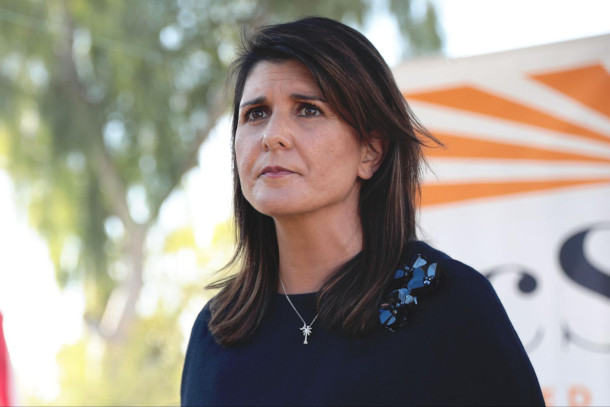
In contrast to Ramaswamy, former United Nations Ambassador Nikki Haley said climate change is real. (Photo: Gage Skidmore, Flickr, CC BY-SA 2.0)
MATTHEWS: I think my question on climate would just be, how are you going to ensure that all Americans have clean air, clean water, and safe environments to live in? Because I think that we've seen over and over again, recently, Americans denied those rights, and how are we going to deal with these environmental challenges that directly affect people's lives? East Palestine, Ohio comes to mind. After that train derailment, frankly, there wasn't enough kind of action and reassurance from any government entity that, you know, these issues would be resolved and the community would again have clean air and clean water. Flint, Michigan, too, and Jackson, Mississippi. There are just so many instances, right? We can't even list them all. So I think it's just really important that candidates prioritize kind of environmental protection even at the local level.
DOERING: Karly Matthews is Vice President of Communications for the American Conservation Coalition. Thank you so much, Karly.
MATTHEWS: Thanks for having me.
Related links:
- American Conservation Coalition
- Watch the first Republican debate
- Watch the second Republican debate
- Pew Research Center polling on concern about climate change
[MUSIC: Geoff Muldaur, “Got To Find Blind Lemon Part 1” on Beautiful Isle Of Somewhere, by Muldaur, Tradition & Moderne GmbH Records]
O’NEILL: Coming up, communities around New Orleans are racing to protect water supplies from the saltwater moving up the Mississippi River. That’s just after the break.
Stay tuned!
ANNOUNCER: Support for Living on Earth comes from Sailors for the Sea and Oceana. Helping boaters race clean, sail green and protect the seas they love. More information @sailorsforthesea.org.
[CUTAWAY MUSIC: Mehmet Ali Sanlikol & Whatnext?, “Turkish Hipster” on by Mehmet Ali Sanlikol, on Turkish Hipster: Tales From Swing To Psychedelic, Dunya]
Salt Water in the Mississippi
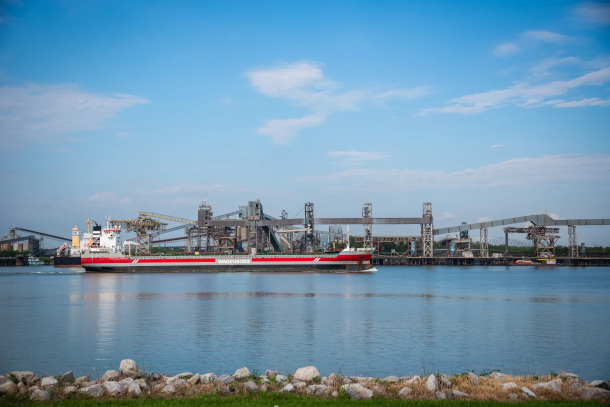
A shipping boat glides up the Mississippi River across from the U.S. Army Corps of Engineers' New Orleans District headquarters off Leake Avenue on Sept. 15, 2023. (Photo: Halle Parker, WWNO)
O’NEILL: It’s Living on Earth, I’m Aynsley O’Neill
DOERING: And I’m Jenni Doering.
The great Mississippi River moves an enormous amount of water south from the central and Eastern US, but not as much this year thanks to drought conditions. Usually, the freshwater that flows south in the Mississippi pushes back salt water as the river nears the Gulf of Mexico, but now that salty water is slowly seeping upriver towards New Orleans and contaminating water supplies. Experts say that freshwater species should be fine, but for human’s high levels of salt in drinking water can worsen high blood pressure. President Joe Biden has declared a federal emergency at the request of the Louisiana Governor, freeing up federal funds to address the situation. Here to tell us more is Halle Parker, who reports on the environment for public radio station WWNO in New Orleans. Welcome to Living on Earth Halle!
DOERING: So what are experts saying about what could happen if people actually drink this water?
PARKER: So that's one of the things that's pretty crazy about what's going on down here is just how much uncertainty there still is. Right now, there isn't any sort of like effect for any places that are highly populated, you know, like New Orleans, or Jefferson Parish, the metropolitan area around New Orleans. But people down in Plaquemines Parish, which is a more sparsely populated area to the south have been dealing with this for a while, right? They actually saw a lot of salt in their water for months on end, and it was like around 1600 parts per million. And just to put that into perspective, 250 parts per million is what the EPA, the Environmental Protection Agency, says is when you start, you know, to actually be able to taste that salt in the water. So 1600 parts per million is like six and a half times that.

U.S. Army Corps of Engineers Col. Cullen Jones, who commands the New Orleans District, provides an update on his office's measures to address a "saltwater wedge" moving up a historically low Mississippi River during a news conference on Sept. 15, 2023. (Photo: Halle Parker, WWNO)
DOERING: Wow, that's a lot.
PARKER:Yeah, It's a lot of salt. At that point, no one's drinking the water or even for some people, like you can use it to brush your teeth, but you're not really going to it really just doesn't taste very good. But something that our officials are really grappling with is trying to understand like at what point at what level of salt, do we need to worry about corrosion? And also does that level of salt that's an issue does that change over the amount of time that that salt water is around.
DOERING: And of course, corrosion of lead pipes was something that was happening in Flint, Michigan, and led to a lot of the high levels of lead in that water. To what extent could this happen in this case?
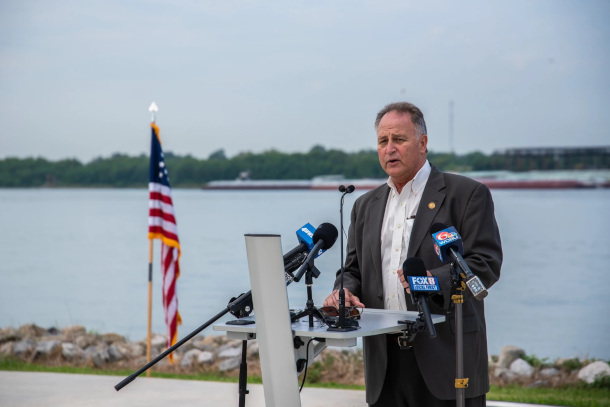
Plaquemines Parish President W. Keith Hinkley describes how his office has coped as saltwater moving up the Gulf of Mexico has contaminated drinking water for much of his parish this summer during a news conference on Sept. 15, 2023. (Photo: Halle Parker, WWNO)
PARKER: Yeah. So the risk is for real, it's a very real risk down here. So our mayor, Mayor LaToya Cantrell, told us that at least from their initial analysis, which is still ongoing, they're still mapping out and trying to figure out where exactly lead pipes are, how many they have, but they've already come across at least 50,000 lead pipes in New Orleans. And Jefferson Parish, that metro area close to us doesn't even know yet, they haven't started studying how many lead pipes they have. So it's really this concerning and also still open question for people. And you know, that's part of why what's happening with the saltwater intrusion is so concerning for people down here. There's just so much uncertainty around what's going to happen.
DOERING: Yeah and like you said, officials aren't necessarily sure exactly where this tips over into something that could damage infrastructure. But I imagine that the risks of that are great enough and the consequences are great enough that we don't want to really get close to that.

A graphic depicting what a saltwater wedge looks like, how it interacts with freshwater, as well as the sill, or underwater barrier, constructed by the Corps in July 2023. (Photo: U.S. Army Corps of Engineers)
PARKER: Exactly, yeah, no one wants to see lead pipes start corroding, and leaching into water, we already have issues with lead in our soil. So we don't need any more exposure down here. I know that over in Jefferson Parish, they've already started to at least begin introducing like a type of phosphate, interestingly enough into their water system. to try to avoid and prevent corrosion from happening. And that is something that we're waiting to hear if New Orleans is looking at as well. So there might be some options here for avoiding corrosion, depending on how bad the salt level gets here.
DOERING: Yeah, it's good to hear that there are some solutions, potentially, in some ways to protect the infrastructure. What other solutions to this problem of saltwater moving up the Mississippi River are officials proposing?
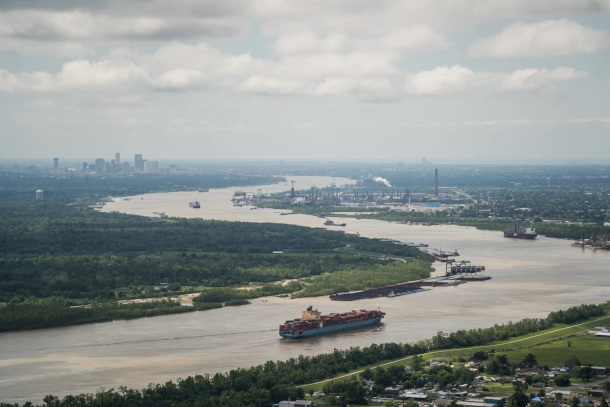
An aerial view of barges and container ships traveling down the Mississippi River in April 2022. Industrial plants line the riverbanks. (Photo: Kezia Setyawan)
PARKER: Yeah, really good question. So, you know, if you go talk to these officials, they'll say that they're looking at anything and everything. But right now, there's kind of like a multi pronged approach happening. So different agencies are doing different things like we have the Army Corps of Engineers coming in to really support of course, the whole region. But they're going to be especially helpful for some of the smaller water treatment plants in this area. They're able to provide things like water barges where you chip in fresh water from up higher in the river that's not being affected by this saltwater wedge, and take it down to those water treatment plants that are being affected, so that they have some fresh water to use to make sure that they have enough to dilute the water in their system so that we are not able to taste that salt, that additional salt in the water. And then beyond that, aside from those smaller water treatment plants that have the option of maybe getting water from a larger plant or from a water barge or from a reverse osmosis unit, our larger plans in New Orleans and in Jefferson Parish, they're really looking to just make a new pipeline. Like move where they're taking water from or getting at least some of their water from and moving that higher up the river similar to that water barge solution. And using those new pipelines to pull in water from a safe area of the river and bring it back down to feed into those really large systems that like to compare some of these systems are only pumping out you know, like 4 million gallons of water a day, which you know, sounds like a lot but then you think about these gigantic plants in there pumping like 140 million gallons of water a day.
DOERING: So what about farms and agriculture? How might the saltwater wedge affect those?
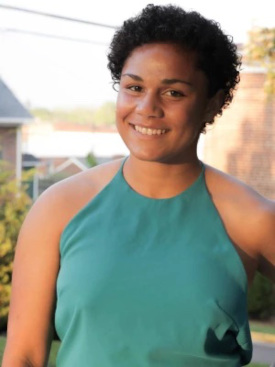
Halle Parker reports on the environment for WWNO's Coastal Desk. (Photo: Courtesy of Halle Parker)
PARKER: Yeah, so, saltwater, especially saltwater intrusion has actually been affecting, you know, South Louisiana for a while now, usually doesn't mean that it's coming up the Mississippi River, typically that's in like actual groundwater in the water table rising just because a lot of this region is sinking at a faster rate than other areas across the country. And so when that happens, the saltwater has the opportunity to move up in the soil. So I just want to make it clear that this isn't a new issue that farmers down here are dealing with. But they are of course incredibly concerned about the saltwater wedge, because where are they supposed to get the water to water their crops? Normally, that would be coming from the Mississippi River to help irrigate, especially down in Plaquemines Parish where a lot of farmers are citrus farmers. And I've gotten there after hurricanes. And if you get, you know, a strong surge from hurricanes of saltwater in the area, and it sits around, all of that salt starts to seep into the soil. And if you don't get some rain, or if you don't have a way to flush it out, then that can actually start poisoning your crops, you know, like they're tolerant to salt up to a certain extent, but you need to be able to get that salt out and refresh the soil. And if they're not able to get you know, that fresh water from the river that makes it really difficult for them, they have to try to find another source of fresh water to keep their crops alive. So it's a big concern for them.
DOERING: Halle, what are experts saying about the role that climate change might play in all of this?
PARKER: Yeah, that's a super important question. So really, when you think about why the saltwater intrusion is happening this year, you think about the drought that's happening. And not only the drought this year, but the drought that happened last year, too. These are two events that are compounding on top of each other. And they're the types of extreme weather that are going to become more likely and more frequent due to climate change. And so when I spoke with John Sabo, who is the director of Tulane University's ByWater Institute, he said that really we shouldn't expect this to become a new normal where it happens every single year but it is something that we should be prepared to have happen more frequently and more often. And that's partially because of drought, like I mentioned, but also because of sea level rise. And so you know, as the Gulf of Mexico continues to rise that could make it easier for it to start to intrude upward.
DOERING: Halle Parker reports on the environment for public radio station WWNO in New Orleans, Louisiana. Thank you so much, Halle.
PARKER: Thanks for talking with me, Jenni.
Related links:
- New Orleans Public Radio | “Salt Water Threatens South Louisiana Drinking Water Second Year in a Row Amid Severe Drought”
- NOLA | “Pricey Pipeline Plan to Protect New Orleans Drinking Water Detailed. Officials Say There’s Time”
- Bloomberg | “They Dredged the Mississippi River for Trade. Now a Water Crisis Looms”
- WGNO | "U.S. Army Corps of Engineers gives update on timeline of saltwater intrusion in Louisiana"
[MUSIC: Fred McDowell, “Baby” on Mississippi Blues by Mississippi Fred McDowell, Black Lion Records]
Rocks from Another (Little) World
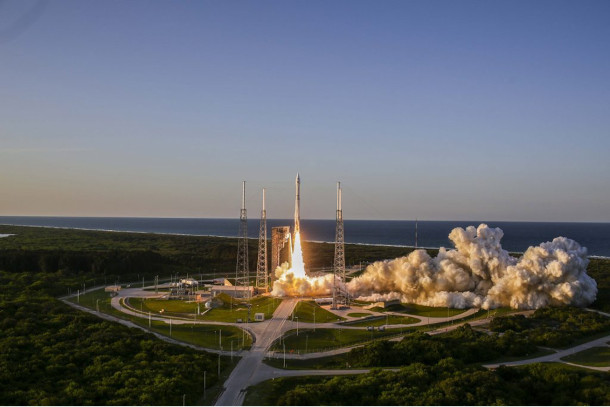
The OSIRIS-REx spacecraft is launched via a United Launch Alliance Atlas V 411 Rocket on September 8, 2016. (Photo: United Launch Alliance, Courtesy of AsteroidMission.org)
O’NEILL: On September 24, the spacecraft OSIRIS-REx flung a capsule with precious cargo back to Earth. It contained bits of surface material taken from the asteroid Bennu, making it the first U.S mission to bring an asteroid sample home. The OSIRIS-REx spacecraft launched in 2016 and collected its sample from Bennu in 2020. Dr. Vicky Hamilton is a planetary geologist at Southwest Research Institute in Boulder Colorado, and a Co-Investigator on the OSIRIS REx Mission. I asked her why scientists are so eager to get their hands on these rocks.
HAMILTON: The goal of the mission is to return a pristine sample of a carbonaceous asteroid. And what that means simply is an asteroid that has a large amount of carbon on it. And the whole point of this is because meteorites from these asteroids exist, but they're contaminated when they fall to Earth, they pass through our atmosphere, they interact with our biosphere and our hydrosphere, and that changes them and it changes their chemistry. And so by going and collecting a pristine sample of one of these asteroids, we can take it into the laboratory and look at it and study it without all those interferences from our own planet.
O'NEILL: And how did the asteroid Bennu get selected? What were you looking for, that makes it the ideal asteroid to go after.
HAMILTON: Any asteroid that we would visit needed to meet a series of criteria, it needed to be in an earth crossing orbit, because one of the other goals of the mission is to understand potentially hazardous asteroids, it needed to be in a location and with an orbit that we could easily send a spacecraft to and return to Earth. Most NASA missions don't need to come back. But this one did. So we needed an orbit that was favorable for that, we needed an object that was big enough to operate around with a spacecraft. And we needed it to be a carbon bearing asteroid. And so by the time you kind of put all of the criteria together, we came to a list of about five different asteroids and Bennu ended up being our pick.
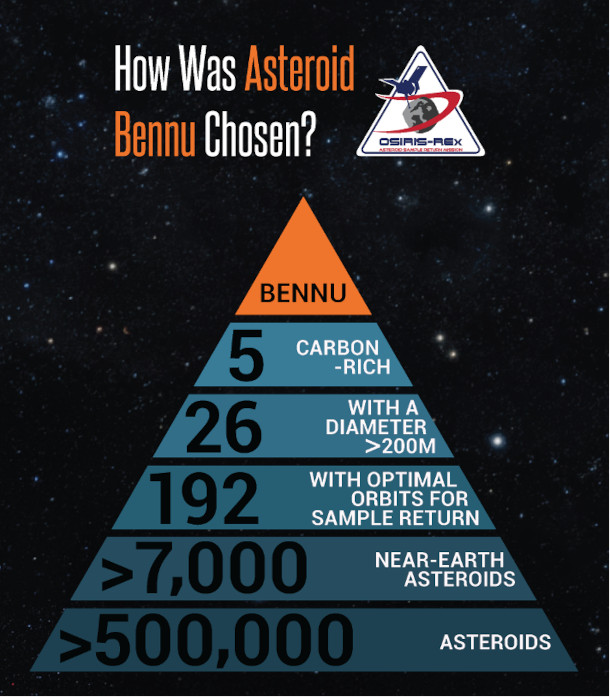
Bennu was one of very few asteroids that met the criteria for the OSIRIS-REx asteroid sample return mission. (Photo: University of Arizona, Courtesy of AsteroidMission.org)
O'NEILL: And tell us a little bit about the Bennu asteroid itself.
HAMILTON: So Bennu is a modestly sized asteroid. It's about 500 meters across, about the size, roughly, of the Empire State Building for folks in the US. And then one of the things that was most interesting was that we didn't know for sure what the surface was going to be like when we contacted it with our spacecraft. So we didn't land on Bennu, we had an arm that stretched out. And we just basically touched the asteroid and then backed away. And it turned out that we sank into the surface more than we expected. And so people have described it being like a ball pit. You know, you go look at this thing that looks like it has a surface, but you jump into it, and you sink way deeper in than you thought you would. And the surface of Bennu was a little bit like that.
O'NEILL: What is it that we are able to learn from asteroids?
HAMILTON: Asteroids are fascinating because they record a part of our solar system's history that is no longer present on the earth. Asteroids are little frozen bits of things that didn't get incorporated into the planets. And they were effectively frozen in time back 4.5-6 billion years ago. And they record the processes that were going on at that time. And so we can use them as literal time capsules. To investigate the processes that were happening as our sun and our solar system, were forming. The carbonaceous asteroids in particular, tell us something about organics and about water, both of which are obviously very important to life on Earth. And so we're hoping to get a glimpse into that past history, where this inventory of chemistry came from what it looked like at the very outset.
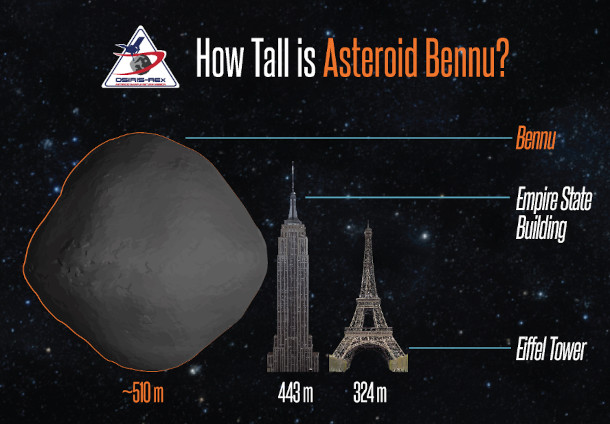
Asteroid Bennu is roughly as tall as the Empire State Building. (Photo: University of Arizona, Courtesy of AsteroidMission.org)
O'NEILL: So I want to hear a bit more about what it must have felt like to have that successful return September 24 2023. What was the energy like from you know, the planetary geologists of the world and now that the sample has been safely brought back?
HAMILTON: Oh, it's, it's really exciting. I mean, the event itself is both this mixture of excitement and terror, because you're watching that capsule, you know, enter the Earth's atmosphere, you're you know that it's been released, you know, it's coming back. But you're just biting your nails until you see that parachute deploy. And then when we saw the first pictures of how the capsule had landed in Utah, it was gorgeous. It could not have been any more perfect. I think everybody's just thrilled.
O'NEILL: So I'd like to hear a little bit about the sample that was collected. Did it in fact, arrive in that pristine condition? Have you gotten to look at it? What's it like?
HAMILTON: So the sample canister was taken from its landing spot in the desert into a cleanroom, a temporary cleanroom. And then the very next day, it was flown here to Johnson Space Center in Houston and put into a glove box and for the last week, the curatorial staff here has been very carefully, very methodically, opening things up progressively. Now we have not yet gotten into the innermost part of the sample canister, there's an outer cover. And we opened that up last week. And we got our first look at some sample anyway, which was really exciting because there was some very small particles and sort of large sand grain size, millimeter sized particles sitting outside the sample canister. And so we've actually got a team of people there called our quick look team. And we've handed off some of those particles to them. And they've been off doing some early preliminary analyses. But I think everybody's really waiting and excited to get into the innermost sample canister, because that's where we're hoping that we've still got some sort of bigger chunks, some, some small stones that we'll be able to look at. But the science team is just really excited, we're going to start allocating pieces of the sample to our science team members around the world, just as soon as we can and start really going to work on the science.
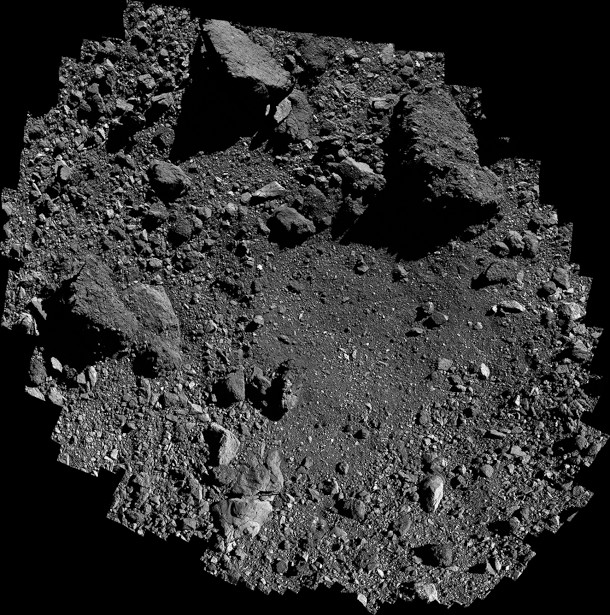
The image above is a mosaic of images obtained by the OSIRIS-REx spacecraft. It shows the sample site Nightingale on asteroid Bennu. (Photo: NASA/Goddard/University of Arizona, Courtesy of AsteroidMission.org)
O'NEILL: How is it going to be distributed to you know, interested parties, who gets a chance to look at it?
HAMILTON: So the sample gets distributed by in part international agreements, part of it actually goes into long term storage for future generations. In fact, the majority of the sample will be put under seal, and protected so that decades or even hundreds of years from now, future scientists will be able to look at the sample, measure it with instruments we haven't even invented yet. But for today, the science team of the OSIRIS REx mission gets about 25% of the return sample, so that we can complete our promise to NASA to perform the science that we said we would do, about 4% of the sample will go to the Canadian Space Agency, who contributed one of the scientific instruments to the mission, about half a percent of the sample will go to the Japan Aerospace Exploration Agency, JAXA. And then lastly, the scientific community will be able to request pieces of Bennu for their own research, starting about six months from now. And so that's a process where scientists like me can write a proposal and say they want a piece of Bennu and what they're going to do with it, and what science they want to study. And then the pieces will be allocated for that purpose. So it becomes available to lots of people now, but also future generations.
O'NEILL: And now it's been sort of a wild journey from the launch in 2016. A sort of picture perfect landing, just you know, just this year, I just want to know, how are you feeling about all this? And what are you looking forward to? Now that we've got this on Earth?
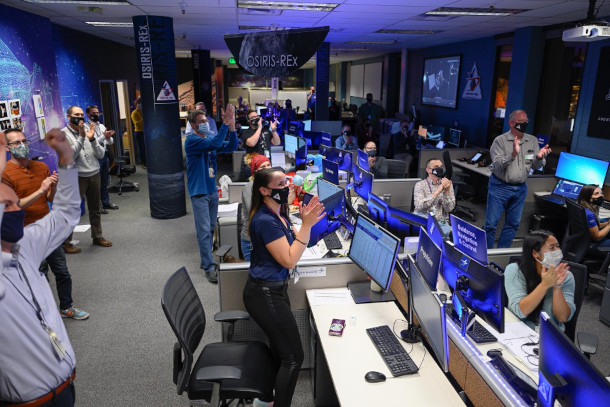
The OSIRIS-REx mission team receives news that the sample return capsule was closed successfully on October 28, 2020. (Photo: Lockheed Martin, Courtesy of AsteroidMission.org)
HAMILTON: I'm still very excited. We all are, we can't believe that we're finally at this point. You know, it's this proposal for this mission was submitted to NASA in 2010. So you know, some of us have been working on it. Since then, some people were working on even the predecessor version of this mission. So for all of us, it's just really exciting to actually be at this moment. For me, the next big thing is when I'm able to get sample and take it back into my lab in Boulder, and start to analyze it and just see what's in there. I mean, I just can't wait to see what's in there, and then be able to compare it to other meteorites that we know about and compare to the predictions we made about what it would look like based on the data that we collected at Bennu.
O'NEILL: Dr. Vickie Hamilton is a co investigator on the OSIRIS REx mission. Dr. Hamilton, thank you so much for joining us today.
HAMILTON: Thank you so much for having me.
Related links:
- NASA | “OSIRIS-REX”
- OSIRIS REx – The University of Arizona | “Asteroid Operations”
- NASA | “Bennu”
- University of Arizona | “OSIRIS-REx”
- NASA Goddard | “NASA’s OSIRIS-REx Mission to Bennu”
- NASA | “Bennu Size Comparison”
[MUSIC: Blue Dot Sessions, “Khfett” on LufaQuest, Blue Dot Studios 2022]
DOERING: Just ahead – hungry cougars in Washington State are winding up with a bounty on their heads. Keep listening to Living on Earth!
ANNOUNCER: Support for Living on Earth comes from Friends of Smeagull the Seagull And and Smeagull’s Guide to Wildlife. It’s all about the wildlife right next door to you! That’s Smeagull, S - M - E - A - G - U - L - L, SmeagullGuide.org.
[CUTAWAY MUSIC: Bill Tapia, “In a Mellow Tone” on Duke Of Uke, by Duke Ellington, MOOnRoom Records]
Beyond the Headlines
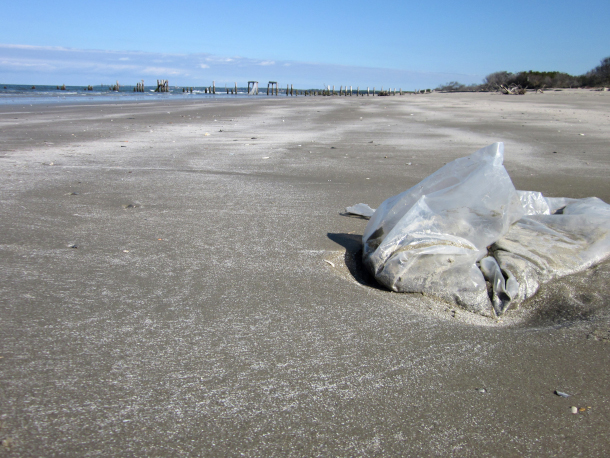
The United States Department of the Interior has announced plans to phase out single-use plastics on public lands like national parks and wildlife refuges. (Photo: Caitlin Finnerty, Chesapeake Bay Program, Flickr, CC BY-NC 2.0)
DOERING: It’s Living on Earth, I’m Jenni Doering
O’NEILL: And I’m Aynsley O’Neill.
O'NEILL: It's just about that time for a look beyond the headlines with our Living on Earth contributor Peter Dykstra. He's joining us now from Atlanta, Georgia. Hey there, Peter, how are you? What do you have for us?
DYKSTRA: I'm doing well, Aynsley, I hope you are too. And the first item for today is that the US Department of Interior is finalizing plans to phase out single use plastic on public lands. And of course, the interior department's public lands cover about 1/5 of the land of the entire United States.
O'NEILL: What are we talking about when we talk about these single use plastics? Peter, is it just the bag that your souvenir comes in or what's going on?
DYKSTRA: Trash bags, food bags from the cafeteria, everything else that's used on the wide open range. And of course, that 1/5 of American land is mostly in the West. Desert, prairie, grasslands, places that a whole lot of people don't normally go except for the national parks. They're included too. One problem here is that they have a phase-out plan that's going to take 10 years without explaining why it would take 10 years to acknowledge the growing problems with plastic and to begin to phase them out. I don't understand that. And they haven't given a full explanation why.
O'NEILL: Yeah, Peter, I'd like to know why myself, but I'd also like to know what else you have for us this week.
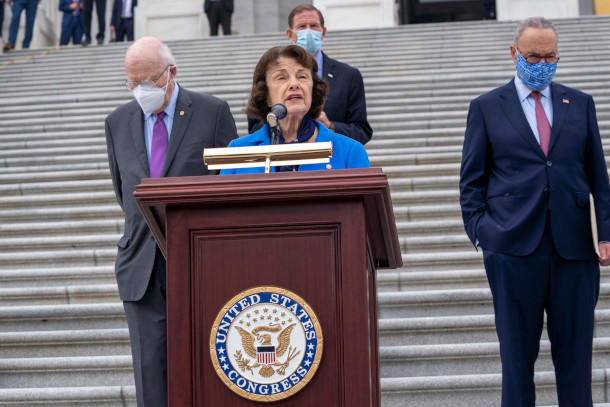
Senator Dianne Feinstein served as a United States Senator from California from 1992 to 2023. (Photo: Senate Democrats, Flickr, CC BY 2.0)
DYKSTRA: Well, this past week, Senator Dianne Feinstein died after a long and distinguished career in politics, including three decades in the US Senate. Her legacy on environmental issues is strong but not perfect. She over the years is recognized as being the leading force behind the creation of Joshua Tree National Park in California. She also took the lowest lying land in the United States and elevated it. Death Valley National Park is now at National Park status thanks to Senator Feinstein. Her legacy isn't perfect, though.
O'NEILL: It sounded pretty good so far, Peter, what's making it so complicated?
DYKSTRA: It is good, but she took some heat from fellow Democrats for opposing the Green New Deal in recent years. The League of Conservation Voters scorecard put her at 96% in the most recent full year of Congress. Her lifetime LCV score was 91%. And that's pretty good.
O'NEILL: Well, there's still some time left in that term, who is going to be replacing Senator Feinstein?
DYKSTRA: Gavin Newsom, the Democratic governor of California has appointed Laphonza Butler to fill out the last year of Feinstein's six-year term. Butler has never served in the House or Senate before. But there are three current members of the House, Katey Porter, Barbara Lee, and Adam Schiff. All three have declared to run for a full six-year term in 2024. All three have high LCV scores. So if any of the Democrats win, California's performance on environmental issues in the Senate should stay largely unchanged.
O'NEILL: Well, we'll have to keep an eye on to see what that means for the future of politics in California. But let's talk a little bit about history now. What do you have for us from the history books this week?
DYKSTRA: We'll go back 200 years, I remember it well. On October 8, 1823 the Erie Canal is formally inaugurated in Albany, New York. It would be a little while longer before the canal is fully operational. But a water shipping route from New York City and the Hudson River to Buffalo and the Great Lakes greatly accelerated the westward push of the United States. It also got that cargo around the Appalachian Mountains, which were a big, big obstacle back then. The railroads eclipsed the canal within 50 years. But the Erie Canal still exists if mostly as a tourist trap, rather than as a state-of-the-art means of hauling cargo.

200 years after its inauguration, the Erie Canal is still in use, chiefly for recreational purposes. (Photo: Duncan Hay, National Park Service, Wikimedia Commons, Public Domain)
O'NEILL: Well, as always, Peter, time marches on. Peter Dykstra is a Living on Earth contributor. Thank you so much, and we will talk to you soon.
DYKSTRA: All right, Aynsley, thanks a lot. Talk to you soon.
O'NEILL: And there's more on the stories on the Living on Earth website. That's LoE.org.
Related links:
- Reuters | “US Finalizes Plans to Phase Out Single-Use Plastic on Public Lands”
- Grist | “Dianne Feinstein Dies, Leaving a Complicated Legacy on Climate Issues”
- More on the history of the Erie Canal
[MUSIC: Slingish, “Erie Canal” on Building Language the Fun Way, Thomas S. Allen, The Heritage Collection]
Living with Cougars on the Olympic Peninsula
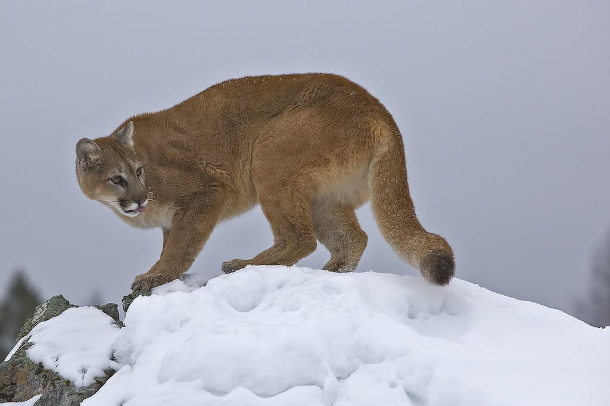
Cougars are also known as mountain lions, pumas, panthers, and catamounts. (Photo: Elaine R. Wilson, Wikimedia Commons, CC BY-SA 3.0)
O’NEILL: The Olympic Peninsula in Washington State is a lush temperate rainforest that’s attracting newcomers from the rest of the Pacific Northwest. But many don’t realize they’re moving into cougar territory. The big cats, which are also known as mountain lions and panthers, are plenty at home on the peninsula already. And in some cases that’s leading to tragedy for pet and livestock owners and the cougars themselves. Liza Gross reported on this for our media partner Inside Climate News. Liza, welcome to Living on Earth!
GROSS: Thank you so much. It's great to be here.
O'NEILL: You write that researchers with the Olympic Cougar Project put collars on cougars to study them. But the cougars just kept dying. What was going on there?
GROSS: So the original idea of this project was to understand the biology and the ecology of these animals. They're wide ranging carnivores, they basically have a huge territory, and especially the young dispersers go out and they try to find homes. But what happens is, because there's a lot of development that's been happening, and more and more people are moving to the Olympic Peninsula, the cats keep winding up dead. And the cats keep winding up dead because they happen upon somebody's goat or somebody's llama that's being raised sort of out in the middle of the woods without being protected. And so a cat see something that looks like prey, it's going to take that animal.
O'NEILL: There's one particular story I want to hear more about. Tell us what happened when a cougar came in contact with the Frey family.

One of the kittens of a mountain lion named Scalp hides in the mossy fallen timber of the big cats' den in forest reserved for timber harvests on the Olympic Peninsula of Washington. (Photo: Michael Kodas)
GROSS: That was actually an unbelievably, remarkably unlucky series of events. So the family actually had a really amazing enclosure for their animals. They had goats, they had chickens, they had geese. It had a roof, it had a totally enclosed fence. But the problem is that enclosure was attached to a shed that had a solar operated door. And what happens is, it was almost like a Rube Goldberg kind of thing, a cougar walked by, there was a motion activated light that was right next to the solar panel shed door, and a cougar walked by, triggered the motion operated light, which opened the solar power door. And this is what one of the experts thinks happened. One of the cats peeked their head in the door, tried to see if they could get inside, then realized they could, wiggled in, and then chaos ensued.
O'NEILL: And what did the family end up losing?
GROSS: It's very sad, they had brought two geese with them from their home in Texas and the geese had sort of been alarm animals sort of, you know, for their chickens, which they had back there as well. And the geese stood up to defend the chickens and the cougar killed them right away. And then several chickens were killed that time. But unfortunately, after that, the family had a habit of sort of walking their goats and letting them free range and whatnot, and let their chickens out. And the same young cougar came by and took one of the goats and several more chickens, which is very sad.
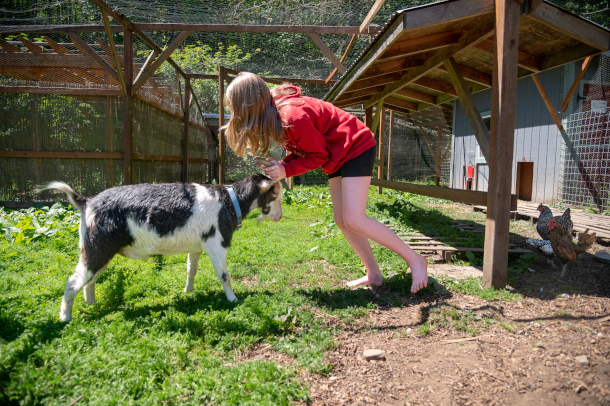
Haddie Frey, 12, wrestles with Flick, a Nigerian dwarf goat that is one of the many animals the family keeps on their property west of Port Angeles on Washington's Olympic Peninsula. The family, which moved to Washington from Austin, Texas, has lost a number of their animals to a mountain lion. (Photo: Michael Kodas)
O'NEILL: How did the family respond to that?
GROSS: They were horrified and very upset. But sadly, they didn't really know who to call or what to do; they were sort of new to the area, they'd come from Texas, and they just sort of watched helplessly. So they didn't know what to do, actually, but their first reaction was not to kill the cat, their first reaction was try to figure out what to do about it, and how to protect their animals. It's really kind of touching because the family really loves animals. And that's why they actually had all these farm animals that they kept more as pets than as you know, money making operation; their chickens, they didn't even sell the eggs with their chickens, they were sort of pets. And what was actually pretty neat about how the Olympic Cougar Project operates, for people who have interactions with the big cats, they offer to come out on a capture with them. And that's sort of a way to educate people to sort of see how these large carnivores operate on the landscape. And actually, it's pretty interesting to see that they're afraid of dogs, just like your house cat might be. And so they have trained hounds, which go on to the scent of the cat, you know, they follow the scent of the cat. And then, they call it "tree" it, they basically chase it up a tree, where the cat's, you know, not very happy about being up there. But when the experts come, the biologists and the team technicians come, they shoot a tranquilizer dart at the cat and it takes a little while for that to take effect. And then they bring the cat down and they put a collar on it so they can study it later.

Olympic Cougar Project co-director Mark Elbroch looks over a cougar kitten moments after it was pulled out of its den during a visit to give the cubs medical checkups and install chips in them. (Photo: Michael Kodas)
O'NEILL: But the sad fact is, it doesn't always end quite so humanely.
GROSS: That's absolutely right. So what usually happens is a landowner will call the state and the state wildlife agency which is the Washington Department of Fish and Wildlife. They're basically called wardens who respond to this kind of an incident. And almost invariably, if they find the cat, they shoot the cat, and that's the way they respond. The Olympic Cougar project has a different response. Panthera is an international wildcat conservation and research organization. They do not have the authority the legal right to go in and capture and tree or relocate the cat, but they work with six tribes that operate on the Olympic Peninsula and they have sovereign authority to do what they would like to do as sovereign nations. And so the call is usually not to kill the cat, but to tree the cat, capture it, study it.
O'NEILL: I have to wonder, how effective is lethal control of cougars? If a cougar puts a toe out of line, it could end up with deadly consequences for it. But is that even something that makes sense in the end?
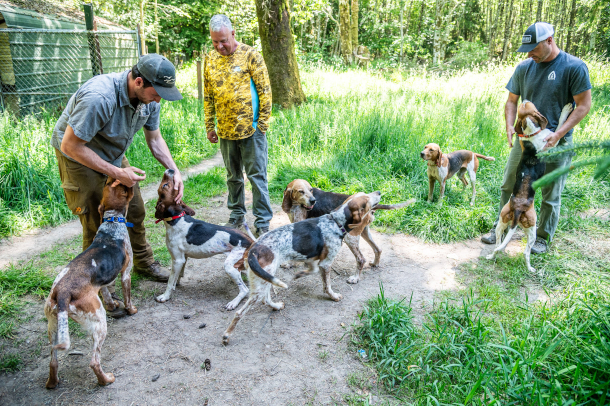
Greg Jones, center, keeps red tick hounds, which he uses to track and tree cougars both for Washington State authorities and for the Olympic Cougar Project. (Photo: Michael Kodas)
GROSS: That's a very good question. And one of the leads in the Olympic Cougar Project, his name is Mark Elbroch, and he's a lion expert who's studied these big cats: cougars, also known as mountain lions, and many, many other names. And he did a literature review to see, does it actually work? If you kill a big cat that's been accused of taking somebody's goat or a llama, does it actually reduce what's called depredation, which is basically the taking of a small farm animal. And he couldn't find any real evidence to show it actually works. And part of the reason is because these animals are opportunistic. And what that means is, they basically prey on things, if they're hungry, that walk in front of them, or that they encounter in their habitat. And so if you kill one cat that happened upon a little goat, that doesn't mean it's going to stop another cat from doing that. And so that raises the issue of what you should be doing.
O'NEILL: And not everybody will necessarily have it in their mind to call the Olympic Cougar Project. But what can people do sort of at the personal level, at the home level, to reduce cougar--human conflict?
GROSS: There are a lot of things, actually, that can be done, starting with just getting a livestock guardian dog, these really large dogs that the cats are afraid of, just like any cat. So this is sort of a Great Pyrenees breed, or a Kangal, or an Anatolian shepherd. And these are the same dogs that shepherds in the Pyrenees have used for years against the brown bears, also known as grizzly bears that they have in France and Spain. And that's one thing that's relatively easy. Other things require more money. These are things like getting enclosures that have a roof, so really good fences that have a roof because cougars can jump at least 15 feet.
O'NEILL: Wow.
GROSS: So if you have a fence that keeps your goat in, it's not going to keep a cougar out. So that's a very important thing to do. Then they also try things like hazing, so shooting rubber bullets at a cat if it seems to be a young cat that just keeps coming back to the property. And then finally, what's really important is for people to stop feeding deer, people actually feed deer, like leaving, you know, apples and this and that and the other thing, and then also cleaning up their garbage so they don't attract raccoons, because raccoons are a pretty steady source of food for the young cats, who are still learning how to take down the bigger prey.
O'NEILL: So we've been talking about this really great program with the Olympic Cougar Project. But they're not the only ones in charge of what happens with cougars. What if anything is happening to find non lethal solutions with the Washington Department of Fish and Wildlife?
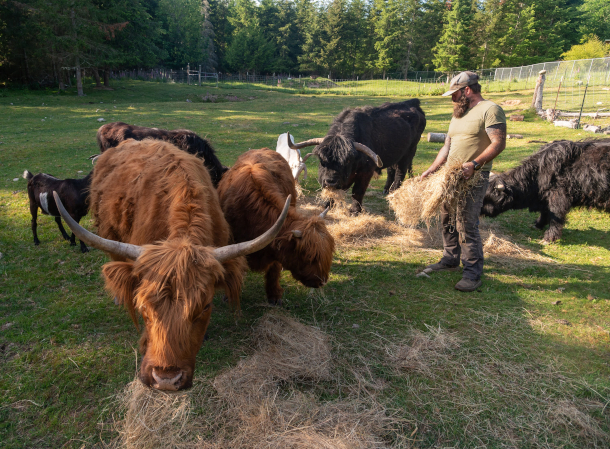
Matt Mayhen has a farm off the grid on Washington's Olympic Peninsula. He's lost livestock to the cougars that roam the dense woods that surround his property and has accompanied Olympic Cougar Project teams to track down cats that were problems for him, which led him to try to operate his farm in a way that allowed the mountain lions to coexist with his family and animals. He's started raising Scottish highland cattle because they are less likely to be preyed on by cougars and can fend them off. (Photo: Michael Kodas)
GROSS: Well, the agency held what they called a cougar focus group last year to solicit input for how to deal with this conflict situation, because they recognize that more people are moving to the area and more conflict is happening. And so they got what they called stakeholders, a variety of people from livestock scientists, houndsmen, who's got a lot of experience with understanding the biology of the cats and how they act. And they got a ton of suggestions. And everybody sort of agreed that they needed to find ways to avoid this lethal removal, which basically is killing the cat whenever a landowner complains that a cat has taken its livestock. There hasn't been much action yet. I mean, the agency has a "living with cougars" pamphlet. But people don't necessarily know about that. And I think that as with most agencies, when you're dealing with the public, there's a problem of staffing and resourcing. And so I think people are still waiting to see what the agency is going to do.
O'NEILL: But I believe there are some signs of hope with a new generation that's being born. And you went out with some of the biologists from the Olympic Cougar Project in search of a cougar den. Can you tell us about what that was like?
GROSS: Well, that was pretty amazing, I have to say. Number one, it was amazing that they were actually able to find the den. And here's the surprising tidbit. The den was in the middle of a timber forest. So it was an active timber forest where you could hear chainsaws whirring in the background, and I was thinking, this doesn't seem good. But surprisingly, the biologists were explaining to me that the timber forests actually almost serve as a refuge for these cats, because they cycle through, so there are decades where the forest isn't being harvested by the lumber companies. And actually, the biologists have a pretty good relationship with the lumber companies who recognize, well, maybe if there's a den there, maybe we won't go in there. We'll work around it. So that hasn't been the biggest issue. The other thing is because it's an actively harvested area, they do a lot of thinning beforehand. So what that means is they're trying to get the other trees to grow bigger, but they leave all this brush behind, and it's just so thick and it's sort of like the best place to stash your kittens, I think, because who could find them? [LAUGHS]
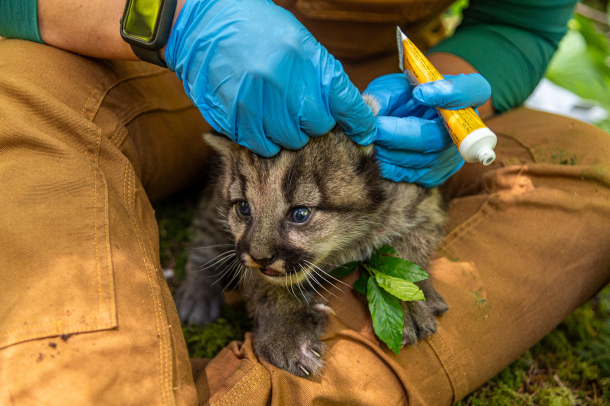
Caitlin Kupar of the Olympic Cougar Project inserted a cougar kitten with a chip and gave it a medical exam while visiting its den on the Olympic Peninsula in June, 2023. (Photo: Michael Kodas)
O'NEILL: And could you tell us a little bit more about the family in this cougar den?
GROSS: Yes, there was a girl and a boy, just three weeks old. And this family carries special meaning for the team. And that's because their mother, Scalp, had surprised everybody by surviving after the state actually made her an orphan at just 10 months old. It's very unusual for young cougars of a year old even to make it on their own, because they can stay with their moms up to 18 months to learn how to take down deer and hunt on their own. And her mother had been killed for taking somebody's goats, a couple goats, and left her an orphan. Yet she managed to make it, and then she seemed to have been one of the youngest cougar mothers that they ever documented. But they named her Scalp because one of the team, Andy Stratton, sedated her and as Andy was trying to retrieve her from the tree, her paw swung around and nicked him on the scalp. And so that was sort of a badge of honor for him. And that's how they named that cat.
O'NEILL: It's incredible to hear about this den, this like quasi-sanctuary within the world of not just the chainsaws cutting down trees, but also the wider world of antagonistic humans. How were the kittens when you found them?
GROSS: Well, it was really amazing to see how delighted the biologists were when they found them, because they've seen all sorts of things. They've gone to dens where the kittens were dead. They've seen very unhealthy kittens. And they were just literally delighted to say, Oh, look at, they're so dark, which is really helpful for camouflage. So they had all these dark spots all over them, which helps you not be able to see them if you happen upon them in this incredibly, you know, dense pile of branches. And they also just seemed full of milk, is what they kept saying, that mama is doing a really good job of taking care of them, because not all cats are as good at taking care of their kittens as the other ones. And the two kittens, even though they were only three weeks old, they had razor sharp claws, their claws were definitely out there and growing. Their teeth were just coming in but the claws were pretty sharp.
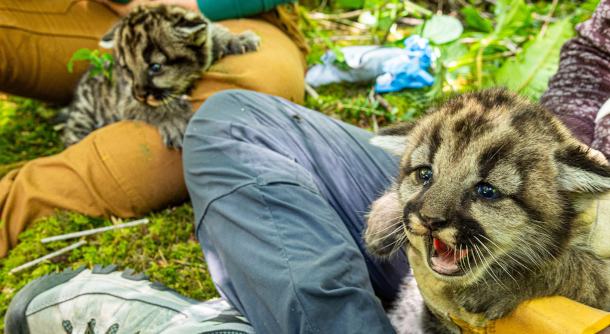
Cougar kittens being examined and chipped outside their den on Washington State's Olympic Peninsula in June, 2023. (Photo: Michael Kodas)
O'NEILL: Wow.
GROSS: I can tell you from experience -- one caught my arm a tiny little bit, a little piece of blood came out but I sort of felt, as a souvenir. So it was, it was quite the experience.
O'NEILL: That was also a badge of honor, huh?
GROSS: It was pretty exciting to be nicked by a little cougar kitten, I have to say! [LAUGHS] Wasn't much damage. [LAUGHS]
O'NEILL: Liza Gross is a reporter for our media partner Inside Climate News. Liza, thank you for taking the time with me today.
GROSS: Thank you so much for having me.
Related link:
Read the story by Liza Gross on Inside Climate News
[MUSIC: Blue Dot Sessions, “Feathersoft” on Barstool, Blue Dot Studios 2016]
O’NEILL: So Jenni, loyal listeners to Living on Earth might remember the stories we’ve done in the past about Katmai National Park and Preserve’s annual Fat Bear Week.
DOERING: Oh yeah Aynsley, wasn’t that where fans from around the world vote online to celebrate their favorite fat brown bear?
O’NEILL: Exactly, and as we go to air, Fat Bear Week is happening now, so check out our website at LoE.org to hear our previous stories and find out how to vote for your favorite chubby champion. That’s LoE.org.
[MUSIC: Blue Dot Sessions, “Towboat Theme” on Towboat, Blue Dot Studios 2020]
O’NEILL: Living on Earth is produced by the World Media Foundation. Our crew includes Naomi Arenberg, Paloma Beltran, Josh Croom, Swayam Gagneja, Mattie Hibbs, Mazzi Ingram, Mark Kausch, Mark Seth Lender, Don Lyman, Sarah Mahaney, Sophia Pandelidis, Jake Rego, El Wilson, and Jolanda Omari.
DOERING: Tom Tiger engineered our show. Alison Lirish Dean composed our themes. You can hear us anytime at L-O-E dot org, Apple Podcasts and Google Podcasts, and like us, please, on our Facebook page - Living on Earth. We tweet from @livingonearth. And find us on Instagram at livingonearthradio. And you can write to us at comments at loe dot org. Steve Curwood is our Executive Producer. I’m Jenni Doering.
O’NEILL: And I’m Aynsley O’Neill. Thanks for listening!
ANNOUNCER: Funding for Living on Earth comes from you, our listeners, and from the University of Massachusetts, Boston, in association with its School for the Environment, developing the next generation of environmental leaders. And from the Grantham Foundation for the protection of the environment, supporting strategic communications and collaboration in solving the world’s most pressing environmental problems.
ANNOUNCER 2: PRX.
Living on Earth wants to hear from you!
Living on Earth
62 Calef Highway, Suite 212
Lee, NH 03861
Telephone: 617-287-4121
E-mail: comments@loe.org
Newsletter [Click here]
Donate to Living on Earth!
Living on Earth is an independent media program and relies entirely on contributions from listeners and institutions supporting public service. Please donate now to preserve an independent environmental voice.
NewsletterLiving on Earth offers a weekly delivery of the show's rundown to your mailbox. Sign up for our newsletter today!
 Sailors For The Sea: Be the change you want to sea.
Sailors For The Sea: Be the change you want to sea.
 The Grantham Foundation for the Protection of the Environment: Committed to protecting and improving the health of the global environment.
The Grantham Foundation for the Protection of the Environment: Committed to protecting and improving the health of the global environment.
 Contribute to Living on Earth and receive, as our gift to you, an archival print of one of Mark Seth Lender's extraordinary wildlife photographs. Follow the link to see Mark's current collection of photographs.
Contribute to Living on Earth and receive, as our gift to you, an archival print of one of Mark Seth Lender's extraordinary wildlife photographs. Follow the link to see Mark's current collection of photographs.
 Buy a signed copy of Mark Seth Lender's book Smeagull the Seagull & support Living on Earth
Buy a signed copy of Mark Seth Lender's book Smeagull the Seagull & support Living on Earth

